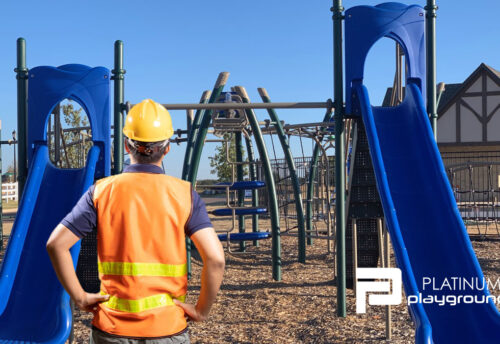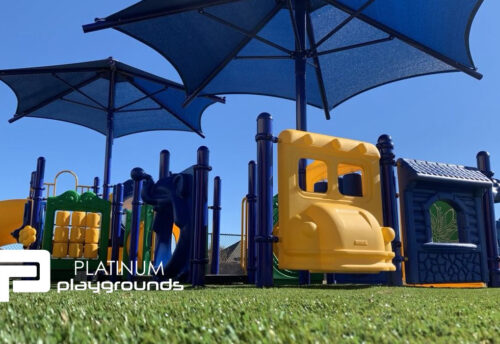Understanding School Playground Safety Standards
School Playgrounds are a cornerstone of childhood, providing kids with a space to explore, play, and develop essential social and motor skills. But for school administrators and public school boards, ensuring these play areas meet the highest school playground safety standards is critical. Every year, more than 200,000 children in the U.S. are treated for playground-related injuries, many of which could have been prevented with proper safety measures.

When selecting commercial playground equipment, schools must adhere to national safety regulations to minimize liability and create a secure play environment. This guide will walk you through the most important playground safety standards, including National Program for Playground Safety (NPPS) guidelines, ASTM standards, and Consumer Product Safety Commission (CPSC) recommendations. We’ll also highlight common safety pitfalls, discuss impact-resistant surfacing, and outline best practices for installation and maintenance.
Understanding Key School Playground Safety Standards
Ensuring compliance with school playground safety standards is not just about avoiding legal trouble—it’s about protecting children. Here are the most critical safety standards every school should follow:
1. Consumer Product Safety Commission (CPSC) Guidelines
The CPSC Public Playground Safety Handbook provides detailed recommendations on playground equipment safety, covering fall heights, spacing, materials, and surfacing requirements. Schools should focus on:
- Age-appropriate equipment (separate play areas for ages 2–5 and 5–12).
- Guardrails and barriers to prevent falls from elevated structures.
- Safe swing zones with adequate spacing between swings and soft surfacing below.
2. ASTM International School Playground Safety Standards
The ASTM F1487 is the leading safety standard for public playground equipment. It sets requirements for:
- Structural integrity (materials that withstand weather and wear).
- Entrapment prevention (eliminating openings that could trap a child’s head, limbs, or clothing).
- Impact-resistant playground surfacing to reduce injury risks.
3. National Program for Playground Safety (NPPS) Best Practices
NPPS focuses on education and advocacy for playground safety, promoting the S.A.F.E. framework:
- Supervision: Ensuring proper adult monitoring of playground activities.
- Age-appropriate design: Selecting play structures based on developmental stages.
- Fall surfacing: Installing materials like rubber mulch or synthetic turf.
- Equipment maintenance: Conducting regular safety inspections.
Other things to consider when “Choosing the Best School Playground Equipment“.
Common Safety Pitfalls Schools Should Avoid
Even well-intentioned playground installations can pose risks if not executed correctly. Schools should be mindful of these common hazards:
1. Inadequate Fall Protection
A staggering 79% of playground injuries involve falls. Schools should use impact-resistant surfacing such as:
- Poured-in-place rubber for consistent safety coverage.
- Engineered wood fiber mulch (must be regularly maintained to stay effective).
- Synthetic turf with shock-absorbing padding for durability and comfort.
2. Poor Equipment Spacing
Crowded playgrounds increase the risk of collisions and entrapments. Ensure:
- Swings are at least 24 inches apart to prevent side-impact injuries.
- Slides and climbing structures have clear fall zones.
- Pathways allow easy access for children of all abilities, including wheelchair users.
3. Lack of Routine Inspections
Over time, playgrounds deteriorate due to weather, use, and vandalism. Monthly safety inspections should check for:
- Loose bolts or exposed hardware.
- Worn or splintering materials.
- Missing safety padding or surfacing displacement.
The Role of School Playground Safety Surfacing in Injury Prevention
The choice of playground surfacing directly affects injury risk. The best options for schools include:
- Rubber mulch: Affordable and impact-absorbing but requires upkeep.
- Poured-in-place rubber: Long-lasting and highly effective for fall protection.
- Artificial turf with padding: Aesthetically pleasing and durable.
The CPSC recommends that surfacing materials be at least 9 inches deep for effective impact absorption.
Best Practices for Playground Installation and Maintenance
Even the safest playground equipment can become hazardous without proper installation and maintenance. Schools should:
- Work with certified playground installers to ensure compliance with ASTM and CPSC standards.
- Conduct routine maintenance checks to identify wear and tear.
- Train staff on playground supervision protocols to prevent unsafe behaviors.
Why Schools Trust Platinum Playgrounds for Safe, High-Quality Playgrounds
Navigating playground safety standards can be overwhelming, but Platinum Playgrounds simplifies the process. Our team specializes in:
- Custom playground designs that meet ASTM and CPSC safety standards.
- Impact-resistant surfacing solutions tailored to your school’s needs.
- Professional installation and maintenance services to keep your playground safe for years to come.
With a commitment to safety, durability, and compliance, Platinum Playgrounds helps schools create play environments where students can thrive.
Invest in a School Playground Safety
How Schools Can Afford High-Quality Playground Equipment on a Budget
A well-designed playground is more than just a fun space—it’s an investment in children’s health, safety, and development. By following CPSC guidelines, ASTM standards, and NPPS best practices, schools can create secure and inclusive play areas for students.
Ready to build a safer playground for your school? Contact Platinum Playgrounds today for expert guidance, high-quality equipment, and professional installation services!


